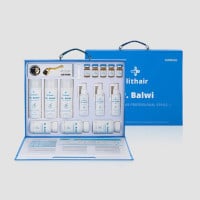
How to Prevent Infections After a Hair Surgery
A hair transplant is a surgical procedure, and like any operation, there’s a small risk of infection. But with the right care, it’s easy to keep this risk to a minimum. In this article, we’ll explain how infections can occur, what factors might increase the risk, and share 6 essential tips to help you heal smoothly and avoid complications. Stay informed, stay prepared, and enjoy a hassle-free recovery.
Are Infections After a Hair Transplant Common?
Hair transplantation is among the least invasive surgical procedures. According to multiple scientific studies, infections occur in fewer than 1% of cases.
This exceptionally low risk is due to several factors. Firstly, the scalp has an excellent blood supply, which promotes quick tissue repair.
Secondly, the incisions made during the procedure are tiny and shallow, limiting exposure to bacteria and facilitating rapid healing.
If an infection is caught early, it can be treated effectively without significant consequences. However, if neglected, it may progress to necrosis.
What is Necrosis After a Hair Restoration?
Necrosis refers to the death of cells or tissue due to a lack of blood supply, often presenting as dark patches on the scalp.
It is important to note that necrosis isn’t always caused by infection. If too many follicular units are extracted or implanted in one area, blood circulation may be disrupted, resulting in necrosis.
Let’s now explore the factors that increase the risk of infection.
What are the Risk Factors?
Diabetes
People with diabetes have a compromised immune system, making them more susceptible to infections. To mitigate this risk, diabetics are often prescribed prophylactic antibiotics, alongside close monitoring of the healing process.
Smoking
Smoking impairs healing after surgery. Substances like nicotine, carbon monoxide, and hydrogen cyanide disrupt blood flow and the delivery of white blood cells, which are crucial for fighting infections.
For smokers, the infection rate rises from around 2% (non-smokers) to 12%.
Graft Extraction Method
There are two main methods for extracting grafts: FUT and FUE. The first involves taking a strip of skin from the donor area, the second involves extracting hair follicles one by one.
FUT requires suturing at the donor location, increasing the risk of infection.
Poor Hygiene

Unsurprisingly, hygiene plays a major role in preventing infections.
Clinic and Equipment
The clinic must sterilise its operating rooms and tools thoroughly before and after the surgery.
Scalp Preparation
To give your transplant the best chance of success, the medical team must sanitise your scalp before surgery with a disinfectant.
Post-Operative Care
Following proper post-operative aftercare instructions is vital to preventing infections during recovery. The clinic should provide you with detailed instructions which you must follow in the days and weeks after your procedure. If the necessary care products are not provided to you, as is the standard at Elithair, it is important that you are given appropriate referrals on what to purchase.
Our 6 Tips for Preventing Infections After a Hair Surgery
- Choose your clinic carefully: Verify the clinic’s certifications and read reviews from other patients.
- Stop Smoking Before and After Surgery: Quit smoking at least 2 weeks before and after the operation to aid healing.
- Adopt a healthy diet: Strengthen your immune system with a diet rich in vitamins, zinc, and proteins to optimise recovery.
- Opt for the FUE DHI method: Avoid the outdated FUT method. Advanced techniques like Direct Hair Implantation (DHI) ensure natural results and quicker healing.
- Follow post-operative instructions to the letter: Rest well, adhere to your aftercare plan, and avoid unnecessary worry – after 10 days, the worst of it is behind you.
- Get follow-up support: Choose a clinic that offers post-surgical support to address any complications promptly.
Conclusion
Your hair transplant marks the end of years of hair loss, with newly implanted follicles revitalising the recipient area. The highest risk of infection occurs during the initial healing phase, particularly as scabs form.
By following these essential tips and opting for a modern method like DHI, you can significantly reduce the risk of complications and ensure a smooth recovery.
Interested in seeing successful hair transplant results? Check out our before-and-after patient photos for inspiration.
FAQ
What are the first signs of an infection after a hair transplant?
Redness, swelling, severe pain, and pus discharge around the grafts are the first signs of infection after a hair transplant.
What treatments are recommended for infections after a hair transplant?
Treatments for infections following hair transplant surgeries typically include antibiotics, topical antiseptics, and targeted medical care.
How long should I monitor for signs of infection post-transplant?
It is advisable to pay close attention during the first few weeks, particularly the initial u003cstrongu003e10 daysu003c/strongu003e.
How can diet influence healing and prevent infections?
A diet rich in vitamins C and E, zinc, and protein strengthens the immune system and aids healing.
What are the long-term effects of untreated infections?
Untreated infections can lead to permanent scarring, graft loss, and scalp damage.
What hygiene precautions should be taken at home post-surgery?
Use mild shampoos, avoid touching or scratching the transplanted area, and follow all professional aftercare advice.
What role do probiotics play in preventing infections?
Probiotics can enhance immune function and promote a healthy bacterial balance, reducing infection risk.
How do I differentiate between normal healing and an infection?
Normal healing may involve slight swelling and scabbing, while infections present with severe pain, redness, and pus.
What additional risk factors exist for people with medical conditions?
Conditions such as diabetes, autoimmune diseases, or blood clotting disorders can increase infection risk.
Why is post-operative follow-up care important for infection prevention?
Regular follow-ups help detect and address issues early, ensuring optimal healing and results.


